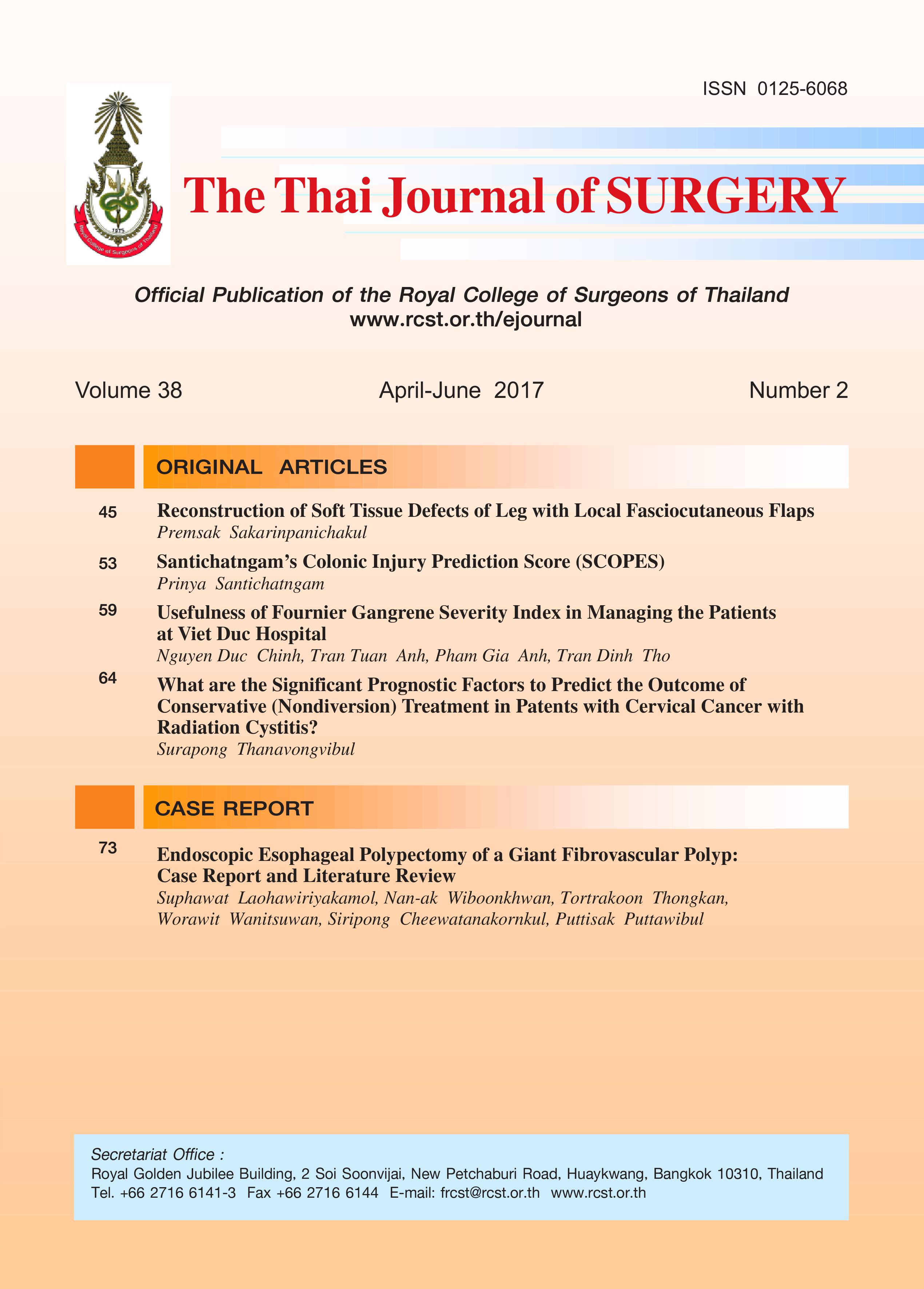Reconstruction of Soft Tissue Defects of Leg with Local Fasciocutaneous Flaps
Keywords:
Leg reconstruction, local fasciocutaneous flapAbstract
Background: Reconstruction of soft tissue defects of the leg remains challenged. The purpose of this study was to evaluate the treatment of soft tissue defects of leg with local fasciocutaneous flaps.
Patients and Methods: Ten patients underwent the reconstruction of leg defects. Local fasciocutaneous flaps were performed to reconstruct leg defects in all patients at Buriram Hospital from July 2014 to March 2016.
Results: Seven of ten flaps survived completely without complication. Three patients (30%) had partial flap necrosis but could be resolved by debridement and split-thickness skin graft. The follow-up time ranged from 1-8 months. Flaps and skin graft on the donor site survived completely.
Conclusion: Using the local fasciocutaneous flaps to reconstruct leg and ankle defects are safe and reliable procedure with a high success rate, however partial flap necrosis remains an important complication.
References
2. Chan JK-K, HarryL, Williams G, Nanchahal J. Soft-tissue reconstruction of open fractures of the lower limb: muscle versus fascio cutaneous flaps. Plast Reconstr Surg 2012; 130:284e -295e.
3. Ayestaray B, Ogawa R,Ono S, Hyakusoku H. Propeller flaps: classification and clinical applications. Ann Chir Plast Esthét. 2011;56:90-8.
4. Pignatti M, Pasqualini M, GovernaM, Bruti M, Rigotti G. Propeller flaps for leg reconstruction. J Plast, Reconstruc Aesth Surg [Internet]. [cited 2016Mar17]. Availablefrom:https://www.jprasurg.com/article/S1748-6815(08)00175-7/abstract
5. Bravo FG,Schwarze HP. Free-style local perforator flaps: concept and classification system [Internet]. [cited 2016 Mar 17]. A vailable from: https://www.sciencedirect.com/science/article/pii/S1748681508012072
6. Wallace CG, Kao H-K, JengS-F, Wei F-C. Free-style flaps: a further step forward for perforator flap surgery. Plast Reconstr Surg 2009;124:e419-26.
7. Lecours C, Saint-CyrM, WongC, Bernier C, Mailhot E, Tardif M, et al. Freestyle pedicle perforator flaps: clinical results and vascular anatomy. Plast Reconstr Surg 2010;126:1589-603.
8. Vergara-AmadorE. Distally-based superficial sural neurocutaneous flap for reconstruction of the ankle and foot in children. J Plast Reconstr Aesthet Surg 2009;62:1087-93.
9. Chai Y, Zeng B, Zhang F, Kang Q, Yang Q. Experience with the distally based sural neurofascio cutaneous flap supplied by the terminal perforator of peroneal vessels for ankle and foot reconstruction. Ann Plast Surg 2007;59:526-31.
10. Morgan K, Brantigan CO, Field CJ, Paden M. Reverse sural artery flap for the reconstruction of chronic lower extremity wounds in high-risk patients. J Foot Ankle Surg 2006;45:417-23.
11. ChenS-L, Chen T-M, WangH-J. The distally based sural fascio musculo cutaneou sflap forfoot reconstruction. J Plast Reconstr Aesthet Surg 2006;59:846-55.
12. Olawoye OA, AdemolaSA, Iyun K, Michael A, Oluwatosin O. The reverse sural arteryflapforthe reconstruction ofdistal third ofthe leg andfoot. Int Wound J 2014;11:210-4.
Downloads
Published
How to Cite
Issue
Section
License
Articles must be contributed solely to The Thai Journal of Surgery and when published become the property of the Royal College of Surgeons of Thailand. The Royal College of Surgeons of Thailand reserves copyright on all published materials and such materials may not be reproduced in any form without the written permission.



